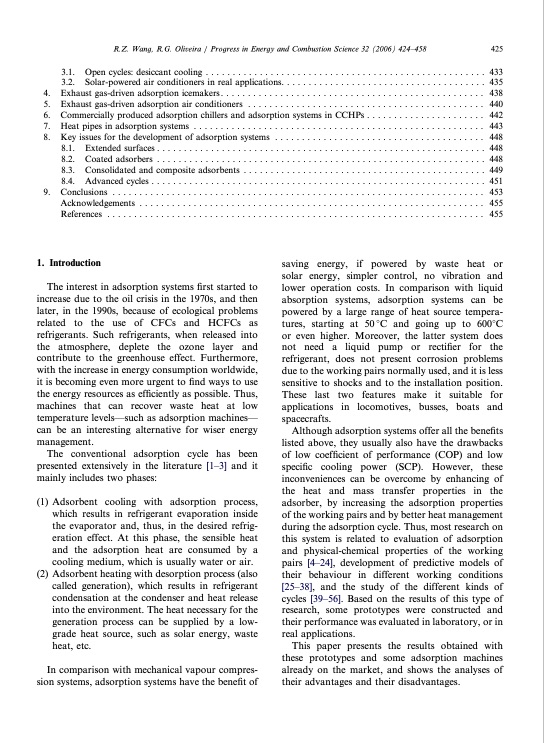
PDF Publication Title:
Text from PDF Page: 002
ARTICLE IN PRESS R.Z. Wang, R.G. Oliveira / Progress in Energy and Combustion Science 32 (2006) 424–458 425 3.1. Opencycles:desiccantcooling.................................................... 433 3.2. Solar-poweredairconditionersinrealapplications...................................... 435 4. Exhaustgas-drivenadsorptionicemakers................................................. 438 5. Exhaustgas-drivenadsorptionairconditioners ............................................ 440 6. CommerciallyproducedadsorptionchillersandadsorptionsystemsinCCHPs...................... 442 7. Heatpipesinadsorptionsystems ...................................................... 443 8. Keyissuesforthedevelopmentofadsorptionsystems ....................................... 448 8.1. Extendedsurfaces............................................................. 448 8.2. Coatedadsorbers ............................................................. 448 8.3. Consolidatedandcompositeadsorbents ............................................. 449 8.4. Advancedcycles.............................................................. 451 9. Conclusions ..................................................................... 453 Acknowledgements ................................................................ 455 References ...................................................................... 455 1. Introduction The interest in adsorption systems first started to increase due to the oil crisis in the 1970s, and then later, in the 1990s, because of ecological problems related to the use of CFCs and HCFCs as refrigerants. Such refrigerants, when released into the atmosphere, deplete the ozone layer and contribute to the greenhouse effect. Furthermore, with the increase in energy consumption worldwide, it is becoming even more urgent to find ways to use the energy resources as efficiently as possible. Thus, machines that can recover waste heat at low temperature levels—such as adsorption machines— can be an interesting alternative for wiser energy management. The conventional adsorption cycle has been presented extensively in the literature [1–3] and it mainly includes two phases: (1) Adsorbent cooling with adsorption process, which results in refrigerant evaporation inside the evaporator and, thus, in the desired refrig- eration effect. At this phase, the sensible heat and the adsorption heat are consumed by a cooling medium, which is usually water or air. (2) Adsorbent heating with desorption process (also called generation), which results in refrigerant condensation at the condenser and heat release into the environment. The heat necessary for the generation process can be supplied by a low- grade heat source, such as solar energy, waste heat, etc. In comparison with mechanical vapour compres- sion systems, adsorption systems have the benefit of saving energy, if powered by waste heat or solar energy, simpler control, no vibration and lower operation costs. In comparison with liquid absorption systems, adsorption systems can be powered by a large range of heat source tempera- tures, starting at 501C and going up to 6001C or even higher. Moreover, the latter system does not need a liquid pump or rectifier for the refrigerant, does not present corrosion problems due to the working pairs normally used, and it is less sensitive to shocks and to the installation position. These last two features make it suitable for applications in locomotives, busses, boats and spacecrafts. Although adsorption systems offer all the benefits listed above, they usually also have the drawbacks of low coefficient of performance (COP) and low specific cooling power (SCP). However, these inconveniences can be overcome by enhancing of the heat and mass transfer properties in the adsorber, by increasing the adsorption properties of the working pairs and by better heat management during the adsorption cycle. Thus, most research on this system is related to evaluation of adsorption and physical-chemical properties of the working pairs [4–24], development of predictive models of their behaviour in different working conditions [25–38], and the study of the different kinds of cycles [39–56]. Based on the results of this type of research, some prototypes were constructed and their performance was evaluated in laboratory, or in real applications. This paper presents the results obtained with these prototypes and some adsorption machines already on the market, and shows the analyses of their advantages and their disadvantages.PDF Image | Adsorption refrigeration

PDF Search Title:
Adsorption refrigerationOriginal File Name Searched:
2008519283773463.pdfDIY PDF Search: Google It | Yahoo | Bing
NFT (Non Fungible Token): Buy our tech, design, development or system NFT and become part of our tech NFT network... More Info
IT XR Project Redstone NFT Available for Sale: NFT for high tech turbine design with one part 3D printed counter-rotating energy turbine. Be part of the future with this NFT. Can be bought and sold but only one design NFT exists. Royalties go to the developer (Infinity) to keep enhancing design and applications... More Info
Infinity Turbine IT XR Project Redstone Design: NFT for sale... NFT for high tech turbine design with one part 3D printed counter-rotating energy turbine. Includes all rights to this turbine design, including license for Fluid Handling Block I and II for the turbine assembly and housing. The NFT includes the blueprints (cad/cam), revenue streams, and all future development of the IT XR Project Redstone... More Info
Infinity Turbine ROT Radial Outflow Turbine 24 Design and Worldwide Rights: NFT for sale... NFT for the ROT 24 energy turbine. Be part of the future with this NFT. This design can be bought and sold but only one design NFT exists. You may manufacture the unit, or get the revenues from its sale from Infinity Turbine. Royalties go to the developer (Infinity) to keep enhancing design and applications... More Info
Infinity Supercritical CO2 10 Liter Extractor Design and Worldwide Rights: The Infinity Supercritical 10L CO2 extractor is for botanical oil extraction, which is rich in terpenes and can produce shelf ready full spectrum oil. With over 5 years of development, this industry leader mature extractor machine has been sold since 2015 and is part of many profitable businesses. The process can also be used for electrowinning, e-waste recycling, and lithium battery recycling, gold mining electronic wastes, precious metals. CO2 can also be used in a reverse fuel cell with nafion to make a gas-to-liquids fuel, such as methanol, ethanol and butanol or ethylene. Supercritical CO2 has also been used for treating nafion to make it more effective catalyst. This NFT is for the purchase of worldwide rights which includes the design. More Info
NFT (Non Fungible Token): Buy our tech, design, development or system NFT and become part of our tech NFT network... More Info
Infinity Turbine Products: Special for this month, any plans are $10,000 for complete Cad/Cam blueprints. License is for one build. Try before you buy a production license. May pay by Bitcoin or other Crypto. Products Page... More Info
| CONTACT TEL: 608-238-6001 Email: greg@infinityturbine.com | RSS | AMP |